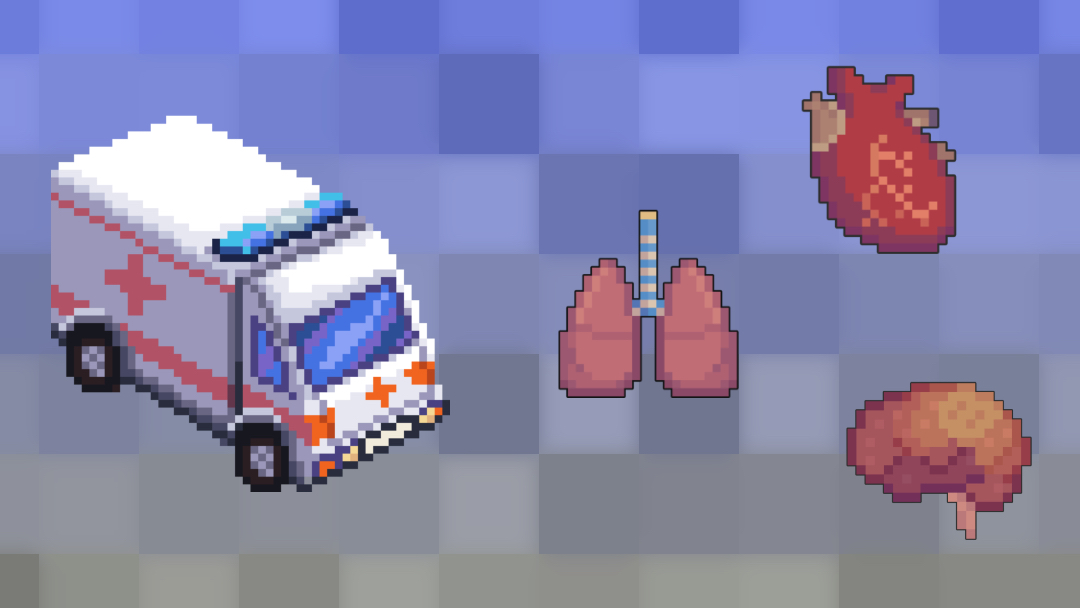- 📖 Geeky Medics OSCE Book
- ⚡ Geeky Medics Bundles
- ✨ 1300+ OSCE Stations
- ✅ OSCE Checklist PDF Booklet
- 🧠 UKMLA AKT Question Bank
- 💊 PSA Question Bank
- 💉 Clinical Skills App
- 🗂️ Flashcard Collections | OSCE, Medicine, Surgery, Anatomy
- 💬 SCA Cases for MRCGP
To be the first to know about our latest videos subscribe to our YouTube channel 🙌
The Geeky Medics list of paramedic mnemonics has been curated to help you remember important paramedic concepts and facts.
Our list of paramedic mnemonics includes patient assessment, resuscitation and communication.
For basic sciences, see the Geeky Medics list of anatomy mnemonics. We also have a list of general medical mnemonics.
Patient assessment
Primary survey: DRc ABCDE
- Danger
- Response
- Catastrophic haemorrhage
- Airway
- Breathing
- Circulation
- Disability
- Expose/examine/environment
See our ABCDE guide for more details.
Stroke: BEFAST
- Balance
- Eyes
- Face
- Arms
- Speech
- Time (critical)
See our stroke article for more details.
Respiratory/chest assessment: TWELVE FLAPS
- Tracheal deviation
- Wounds and bleeding
- Surgical emphysema
- Laryngeal crepitus/injury
- Distended neck veins
- Expose and examine the chest
- Feel
- Look
- Auscultate
- Percuss
- Search back and sides
History taking: SAMPLE
- Signs and symptoms
- Allergies
- Medication
- Past medical history
- Last oral intake
- Events leading up to presentation/injury
Past medical history: JAMTHREADS
- Jaundice
- Anaemia
- Myocardial infarction
- Tuberculosis / thyroid disorders
- Hypertension
- Rheumatic fever
- Epilepsy
- Asthma
- Diabetes
- Stroke / sickle cell
Paediatric assessment triangle: ABC
- Appearance
- Work of breathing
- Circulation
Newborn assessment: APGAR
- Appearance
- Pulse
- Grimace
- Activity
- Respirations
See our newborn life support (NLS) guide for more details.
Pain: SOCRATES
- Site
- Onset
- Character
- Radiation
- Associated signs & symptoms
- Timing
- Exacerbation or relief
- Severity
See our SOCRATES guide for more details.
Pain: OPQRST
- Onset
- Provocation
- Quality
- Radiates
- Severity
- Timing
Level of consciousness: ACVPU
- Alert
- Confusion (new)
- Voice
- Pain
- Unresponsive
See our ACVPU guide for more information.
Resuscitation
Reversible causes: 4 Hs and 4 Ts
- Hypoxia
- Hypovolaemia
- Hypokalaemia/hyperkalaemia (and other electrolyte disorders)
- Hypothermia/hyperthermia
- Tamponade
- Tension pneumothorax
- Toxins
- Thrombosis
See our reversible causes of cardiac arrest guide for more details.
Traumatic cardiac arrest: HOTT
- Hypovolaemia
- Oxygenation
- Tension pneumothorax
- Tamponade
Communication
Information exchange: ASHICE
- Age
- Sex
- History
- Injuries/illness
- Condition
- Estimated time of arrival (ETA)
See our prehospital communication guide for more details.
Information exchange: ATMISTER
- Age
- Time of incident
- Mechanism of injury
- Injuries/illness
- Signs and symptoms
- Treatment given
- Estimated time of arrival
- Special requirements
See our prehospital communication guide for more details.
Information exchange: SBAR
- Situation
- Background
- Assessment
- Recommendations
See our SBAR guide for more details.
Information exchange: IMIST-AMBO
- Identification of patient
- Mechanism of injury or medical complaint
- Injuries or information related to the complaint
- Signs (observations)
- Treatment or trends
Pause for questions
- Allergies
- Medications
- Background
- Other information
See our prehospital communication guide for more details.
Documentation structure: medical model
- PC: Presenting complaint
- HPC: History of presenting complaint
- PMHx: Previous medical history
- PSHx: Previous surgical history
- Allergies
- DHx: Drug history
- SHx: Social history: care / home setup (including layout of house), smoking, alcohol
- FHx: Family history
- ROS: Review of systems (neurological, cardiovascular, respiratory, gastrointestinal, genitourinary, musculoskeletal, integumentary)
- IMP: Impression
- Plan: Treatment plan
Major/significant incident information sharing: METHANE
- Major or significant incident declared / standby
- Exact location
- Type of incident
- Hazards
- Access and egress
- Number of patients and severities
- Emergency services on scene and required




